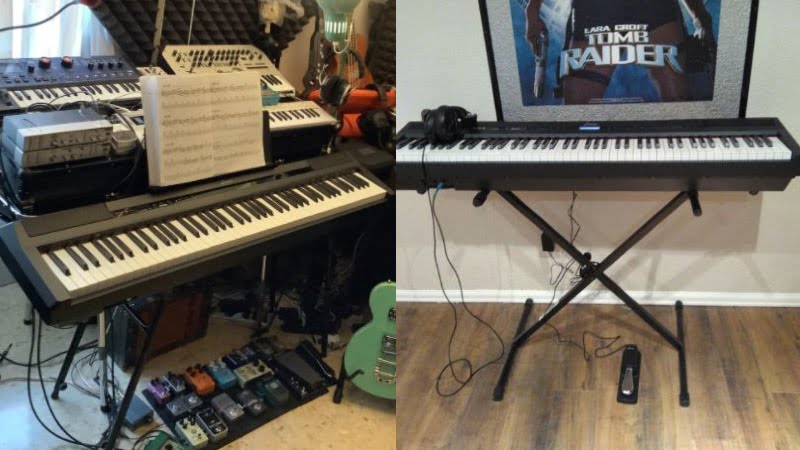The Donner DEP-10 vs Donner DEP-20 debate is one that rages on in the piano community. Since both of these models offer a wide range of benefits at very affordable price points, it’s easy to see why these two are considered some of the best beginner digital pianos on the market today.
And after doing all the research and listening to the two pianos myself, I found that the Donner DEP-20 is easily the better option. While it’s a very affordable piano under $500, it comes with different playing modes, a wide sound library, and fully-weighted keys to provide a realistic piano feel.
While the Donner DEP-10 is a good piano, I found it lacking in a lot of areas. This piano doesn’t have too many voices, only features semi-weighted keys, and doesn’t offer the same versatility as the Donner DEP-20. However, the piano is lightweight and easy on the fingers, which could make it a great choice for kids.
Donner DEP-10 vs DEP-20: Comparison Chart




Last update on 2025-04-14 / Affiliate links / Images from Amazon Product Advertising API
Donner DEP-10 vs DEP-20: The Differences
While I found the Donner DEP-20 to be the winner by miles, I was only able to come to the conclusion after comparing all the features against each other. And in doing this, I found that the Donner DEP-20 won out by 3-1. In fact, the DEP-20 blew the competition out of the water in almost every category with its better tone, feel, and extensive piano features. With that said, the Donner DEP-10 is the more portable option, which could be important for some pianists.
Feel & Playability
The winner: Donner DEP-20
The Donner DEP-10 only features semi-weighted keys. While these are much lighter and easier for kids and beginners to play, it doesn’t provide a realistic piano feel. And since the Donner DEP-20 comes with fully-weighted keys, it was the easy winner when it came to feel and playability.
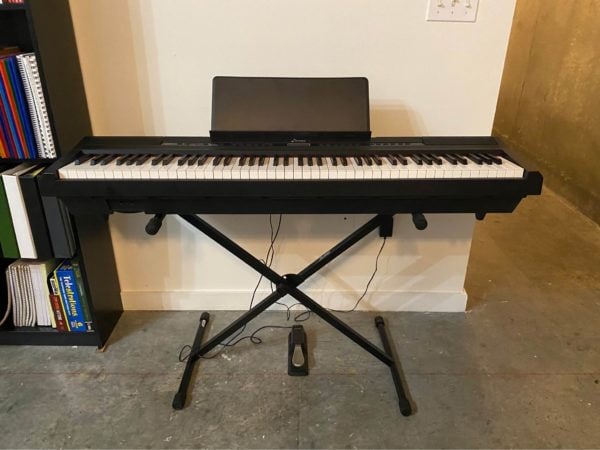
+ Hammer Action
The primary reason the Donner DEP-20 is the winner in this category is the fully-weighted keys. While they aren’t scaled or graded like on the Yamaha P71 or the Korg B2, it does provide a fairly realistic feel. On top of that, fully weighted keys always beat out semi-weighted keys, which is what is on the Donner DEP-10.
Since the Donner DEP-10 only has semi-weighted keys it is a much cheaper option. Having semi-weighted keys also has some benefits, especially for children who are learning to play the piano. For really young students, fully-weighted keys might be too heavy, and in that case, semi-weighted keys are a good choice.
However, as the student gets older, they’ll still eventually want or need to shift to fully-weighted keys, which is why the Donner DEP-20 takes the cake.
+ Touch Sensitivity
The Donner DEP-20 has adjustable touch sensitivity. This allows you to tailor the piano and keys to your playing style, which is great for just about any pianist out there. This is also a great way to compensate for the fairly heavy keys, as you can simply set the sensitivity to light for an easier time.
The Donner DEP-10, on the other hand, doesn’t have this feature. This is largely because you won’t really need to adjust the touch sensitivity on semi-weighted keys, which is a huge point against the DEP-10.
+ Key Texture
The key texture is an area where I found both these pianos lacking. Now, they are relatively affordable pianos, so it would’ve been unfair to expect real wooden keys. But while the pianos have plastic keys, what really let me down was the glossy finish. Donner didn’t coat the keys with anything to give off the same texture as the wooden keys on an acoustic piano.
If either of these pianos had some sort of coating on the keys, it would have been a huge point in their favor. However, since the Donner DEP-20 has better hammer action and touch sensitivity, it’s still the winner in terms of feel and playability.
Tone
The winner: Donner DEP-20
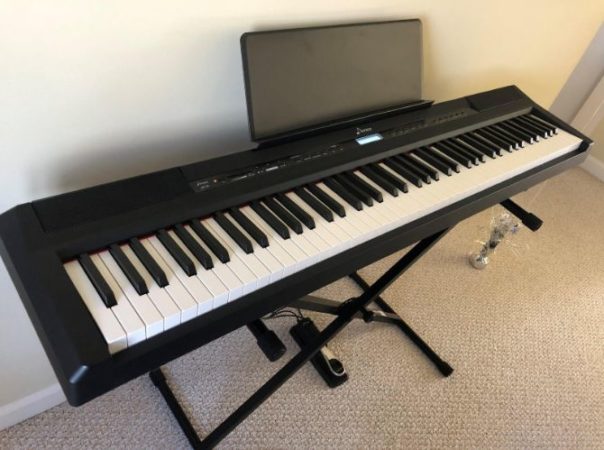
In my opinion, neither of these pianos has the best tone amongst digital pianos. However, that’s about expected from a budget-friendly option, anyway. With that said, the Donner DEP-20 offers a wide set of different voices and a surprisingly accurate tone for its price. For these reasons, I declared it the winner in terms of tone as well.
+ Tone Generation
Both of these pianos have about the same type of tone generation built-in to them. They don’t use sound engines or complex algorithms to generate the sounds. Instead, every time you press a key on either of these pianos, that triggers a sample. This is what you hear on the speakers whenever you play, and to generate good tones, you have to record good samples.
For both pianos, the samples are fairly high-quality. While not the most realistic on the market, they are more than enough for a beginner or even a novice to get by. If you’re looking for a piano to use for recording music, these pianos might not provide the best voices. But if you’re looking for an instrument for rehearsals, practice, and jamming with friends, you can rely on the tones of either of these pianos.
+ Sound Library
The main reason the Donner DEP-20 beat out the DEP-10 in terms of tone is the sound library. The Donner DEP-10 only comes with 10 built-in voices. Now, this is still a fair amount for a beginner’s piano, and it covers just about all your tone needs when starting out with lessons. However, it doesn’t give you that much versatility, which means you might need to end up upgrading as you get better at the instrument.
On the flip side, the Donner DEP-20 comes with 238 voices. In the world of digital pianos, this is a lot. You get acoustic and electric piano tones with the DEP-20, along with other more unique sounds such as strings, bass, synth, and even drums and other SFX! Granted, not all of these tones will be the best quality, and if you’re a beginner, you might not even use a bunch of them.
With all that said, the 238 different voices do provide a lot of versatility and allow pianists to truly find a voice and sound that fits their style.
Piano Features
The winner: Donner DEP-20
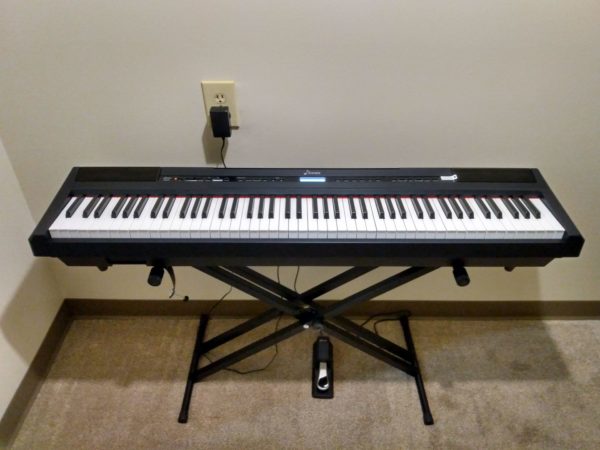
In terms of all the different extra piano features, the Donner DEP-20 was also the clear winner. It has a bunch of different playing modes and superior polyphony, all of which are incredibly important in just about any piano out there.
+ Playing Modes
The Donner DEP-20 comes with split mode, which is a very useful feature, especially for performing and experimenting. With this mode you can divide the piano into two different zones, each with a different voice. For example, you can play piano with the right hand and bass or even drums with the right hand. This gives the illusion of playing multiple instruments at once and is great in performing and accompanist settings.
On top of split mode, the Donner DEP-20 has a recording mode. The Donner DEP-10 shares this feature, which is most useful for piano students. This recording mode is designed to allow you to playback your pieces and listen to the areas where you need to improve. Keep in mind, the recording quality won’t be good enough to put on a song, but is more than enough to judge your own playing.
+ Polyphony
Both of these pianos have the same maximum polyphony. The Donner DEP-20 and DEP-10 both have 128-note maximum polyphony. This is really all you will need as a beginner, and even professional pianists find that 128 polyphony to be more than enough. With either of these pianos, you can play really wide and spread out chords, even with the sustain pedal.
+ Connectivity
Both pianos also offer MIDI connectivity via a USB. This is a very important feature for beginners and even music producers. With a MIDI connection to a computer, you can use the piano to control a variety of virtual instruments and create your own music. On top of that, MIDI connectivity is also useful since you can use it to connect the piano to your computer to use it for a variety of piano learning apps!
Portability
The winner: Donner DEP-10
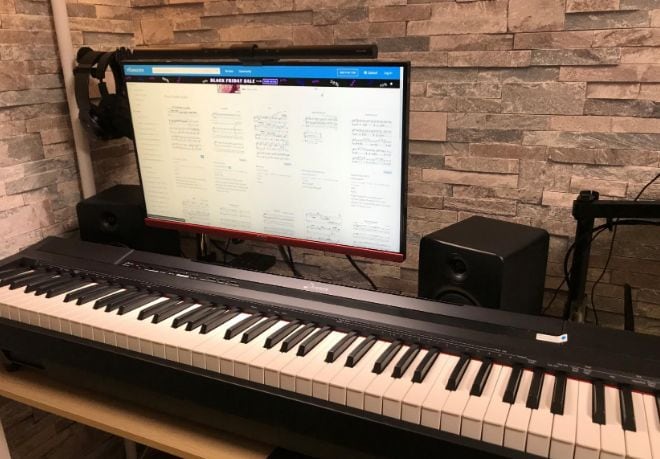
The one area where I found the Donner DEP-10 superior is in portability. If you’re a piano student, you’ll probably have to be bringing your piano to lessons and jams with friends. And in this case, it’s best to have a lightweight piano that you can easily carry around with you.
Now, both of these pianos are full, 88-key keyboards. So, they are far from compact. You can get carrying bags and cases for either piano that will make it much easier to bring around. However, the main reason the Donner DEP-10 is the more portable option is because of its weight. This piano weighs around six pounds lighter than the DEP-20, which makes a big difference when you carry it around a lot.
Donner DEP-10 vs Donner DEP-20: The Similarities
These pianos are not without similarities. After all, they come from the same brand and product line. On top of that, both of the pianos are designed for beginners, though novices won’t mind either of these options out there.
The first and main similarity between the two is the tone generation. Both of the pianos generate their piano and other tones through pre-recorded samples that you trigger when you press down on a key. The result is a fairly realistic tone, and since Donner used high-quality samples, the sound is much better than some other pianos in their price range.
Another similarity between the two is their connectivity options and polyphony. Both of the pianos support MIDI connectivity, which opens a whole range of different possibilities. And with 128-note maximum polyphony, you can easily play wide and dense chords with a lot of notes without worrying about a dip in sound quality.
While these pianos were both designed for beginners, the Donner DEP-10 is best for younger players. The lightweight action is good for smaller and weaker fingers, and will make it much easier to learn the basics. However, the Donner DEP-20 simply has a more realistic feel and a better set of features which is what makes it the better overall option between the two.
Quick Rundown of the Donner DEP-20
- 🎹 【Full-Weighted 88 key keyboard】The digital electric piano is constructed by 88 full-sized hammer action keys with adjustable touch response. This 88-key weighted keyboard allows to adjust your desired playing style.
- 🎹 【238 Tones & 128 Polyphony】 The 88-key weighted keyboard loaded with 238 types of tone like Ukulele, drum, bass, etc. vividly presenting voices of different instruments, arousing your keen to learn music. The digital electric piano with 128-note max polyphony, players could distinguish tone clearly in Chorus & Reverb under various occasions.
- 🎹【Double Keyboard & Control Panel】This 88 key weighted keyboard provides dual-tone mode for combining two voices together, like piano and drum, inspiring to make a new creation. Panel includes sustain pedal, triangle pedal and audio inputs & outputs, perfectly used for music arrangement and an ensemble.
- 🎹 【Multi-Media Settings】This digital piano features with a backlit LCD screen for clearly showing chords names and notation and adjusting wanted tones, recording mode-MIDI, MP3 Player and two 25W amplifiers, bringing you richer and better experience of practice and performance.
- 🎹【Multi-Purpose 88 key keyboard】This streamlined 88-key piano is designed for rehearsing, learning and creating, practice or performance.
Last update on 2025-04-14 / Affiliate links / Images from Amazon Product Advertising API
Quick Rundown of the Donner DEP-10
- 🥇【Full-sized 88 Semi-weighted Keys】Donner DEP-10 digital piano features 88 semi-weighted keys that simulate the real touch of playing a piano. Semi-weighted keys reduce the sense of strength than full-weighted keys for more sensitive touch response to suit different playing styles, provide greater control, and maximizes playing comfort.
- 🥇【8 Excellent Tones&128 Polyphony】DEP-10 88-key electric piano can switch between the sounds of eight different instruments, include Acoustic Piano, Electric Grand Piano, Church Organ, etc. And it can also play two tones at the same time( Dual Tone Setting Function). With 128 polyphony, digital piano can provide super clear rendition, natural feeling of different sounds , perfect for teaching and learning.
- 🥇【Superior Sound Quality】Equipped with two built-in 25W speakers, a sustain pedal, audio input and output, and an MP3 player. DEP-10 delivers a rich and immersive practice and performance experience for players.
- 🥇【Versatile Instrument】You can control the rhythm with diffrent four types of metronome beats. The effects can select from trill, suspension, and DSP. Meanwhile, you can record and arrange your music with the recording mode. DEP-10 is good for players’ different demands and allows you create complex songs with ease.
- 🥇【Modern Sleek Design】The streamlined piano body and textured keys of the DEP-10 88-key digital piano provide an extraordinary playing experience. Beginners can enjoy the beauty of music with this well-designed instrument.
Last update on 2025-04-14 / Affiliate links / Images from Amazon Product Advertising API
Product Videos
Related Articles to Donner Dep 20
- Donner DEP-20 vs DDP-90: Which Donner Piano Wins Out?
- Yamaha P45 vs Donner DEP 20: Which Model Is the Better Option for Beginners?
- Donner DEP-20 vs DEP-45 Comparison: Is the Donner DEP-20 Worth The Higher Price Tag?
- Donner DDP-100 vs DEP-20 Comparison: Can the DEP-20 Beat Out the Donner Console Piano?
- Donner DEP-20 vs Alesis Recital Pro Comparison: Two Great Pianos Designed for Beginners
- Yamaha P71 vs Donner DEP-20: Which Is the Best Beginner Piano?
Related Articles to Donner Dep 10
- Donner DEP-10 Vs Yamaha P-45: Which Digital Piano Is Better?
- Donner DEP-10 Vs Alesis Recital: Which Is The Best Semi-Weighted Digital Piano?
References:
- Donner DEP-20 Fully Weighted 88 Key Portable Digital Piano with Sustain Pedal: https://www.donnerdeal.com/products/donner-dep-20-beginner-digital-piano-88-key-full-size-weighted-keyboard-portable-electric-piano-with-sustain-pedal-power-supply
- Donner DEP-10 Semi-Weighted 88-Key Portable Electric Piano with Sustain Pedal: https://www.donnerdeal.com/products/donner-ddp-10-beginner-digital-piano-88-key-full-size-semi-weighted-keyboard-portable-electric-piano-with-sustain-pedal-power-supply
Lulacruza is an electronic folk duo operating at the junction of the hypermodern and the ancient. Our music weaves together hypnotic female singing, South American folk instruments and electronic processing, while channeling pulsating waves from the source of creation.
Lalucruza is also a community where you can connect with other music lovers to collaborate, exchange ideas and share knowledge. A platform for who wants to learns the basics of playing piano, guitar, drum masters’ technique, etc.. is the premise of our website.
